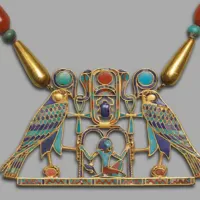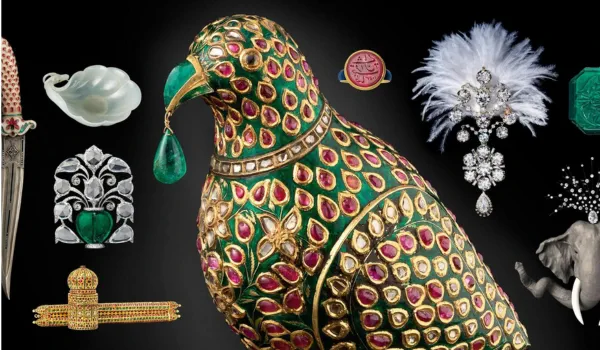Historical Gemstones: Immerse yourself in the rich history of gemstones and their importance in various empires. See how ancient cultures such as Egypt, China, India, Greece and Rome valued these gemstones for their beauty, spiritual meaning and protective properties. Learn about famous gem-loving monarchs, historic mines and the benefits and properties they have provided throughout the ages. In this blog, we explore the timeless appeal of these magnificent gemstones.

Historical Gemstones of Ancient Egypt
In Ancient Egypt, gemstones were not just decorative but also held spiritual significance. Lapis lazuli, turquoise, carnelian, and emeralds were commonly used in jewelry and amulets. These stones were believed to have protective and healing properties, with lapis lazuli particularly revered for its association with the heavens and the divine. Pharaohs were often buried with elaborate gemstone jewelry to ensure their protection in the afterlife.

Chinese Dynasties
The Chinese have a long history with gemstones, particularly jade, which was considered the “Stone of Heaven”. Jade was used for everything from intricate carvings and jewelry to ritual objects and tools. The use of jade dates back to the Neolithic period around 3600 BC, symbolizing purity, moral integrity, and immortality.

Indian Subcontinent
India has been a major player in the gemstone trade for centuries. The subcontinent is known for its diamond mines, which have produced some of the world’s most famous diamonds, including the Koh-i-Noor and the Hope Diamond. Gemstones were integral to Indian culture and mythology, often associated with various gods and used in Ayurvedic medicine.

Historical Gemstones of Greek and Roman Empires
The Greeks and Romans valued gemstones for their beauty and believed in their protective and healing powers. The Greeks associated gemstones with their gods and goddesses, while the Romans used them in various forms of jewelry and amulets. Sapphires, emeralds, and garnets were particularly popular, often believed to bring good fortune and protection in battle.
Medieval Europe

During the Renaissance, gemstones became highly sought after in Europe, with nobility and royalty adorning themselves with precious stones. The Crusades played a significant role in bringing gemstones to Europe, where they were used in ecclesiastical rings and other religious artifacts. The belief in the healing properties of gemstones persisted, with many using them for both physical and spiritual ailments.

The Mughal Empire
The Mughal emperors of India were renowned for their love of gemstones. Shah Jahan, who built the Taj Mahal, was known for his extravagant collection of precious stones. The Mughal jewelry often featured intricate inlay work with rubies, emeralds, and diamonds. These gems were not only symbols of wealth but also of the emperor’s divine right to rule.
Famous Gemstone-Loving Monarchs
- Cleopatra of Egypt: Cleopatra’s love for emeralds and her extensive collection of these gemstones are legendary. She even had her own emerald mines.
- Shah Jahan of the Mughal Empire: Known for his lavish use of gemstones, Shah Jahan’s construction of the Taj Mahal included extensive inlay work with precious stones.
- Emperor Nero of Rome: Nero was known to have used an emerald as a monocle to view gladiatorial games.
- Queen Victoria of England: Victoria had a significant influence on the popularity of gemstones like sapphires and opals during her reign.
Historical Gemstones Mines
- Koh-i-Noor Diamond: Originally mined in India, this diamond has passed through the hands of several empires and is now part of the British Crown Jewels.
- Mogok Valley, Burma: Known for producing the finest rubies, particularly those with the coveted “pigeon’s blood” color.
- Golconda Mines, India: Famous for producing large, high-quality diamonds like the Hope Diamond and the Regent Diamond.
Benefits and Properties of Gemstones
Gemstones have been attributed with various benefits and properties throughout history. They were often used in healing practices, believed to possess powers that could protect the wearer from harm, bring good luck, and enhance spiritual growth. For example, amethysts were thought to prevent drunkenness, while sapphires were believed to bring peace and wisdom.
🔮 Frequently Asked Questions (FAQs)
Historical gemstones are precious stones that have played significant roles throughout history. These gems are often linked to famous empires, monarchs, or historical events, making them culturally and historically valuable.
Empires such as the Egyptian, Roman, Mughal, Byzantine, and British empires were renowned for their use of gemstones in jewelry, royal regalia, and religious artifacts.
Gemstones were symbols of power, wealth, and divine protection. Rulers believed certain stones brought luck, healed illnesses, or provided spiritual strength. They also showcased an empire’s wealth and influence.
Famous historical gemstones include the Koh-i-Noor Diamond, Hope Diamond, Black Prince’s Ruby, and Tavernier Blue. Each of these stones has a fascinating backstory filled with intrigue, power struggles, and global travels.
Gemstones were often traded via ancient routes such as the Silk Road and Maritime Spice Routes. Merchants, royalty, and conquerors transported these treasures across continents, fueling global trade and cultural exchange.
Yes, many ancient cultures believed that gemstones had healing properties and magical powers. For instance, amethyst was thought to prevent intoxication, and emeralds were linked to foresight and rebirth.
Conclusion
The historical significance of gemstones transcends their physical beauty. They have played crucial roles in cultural, religious, and political histories, symbolizing everything from divine favor to personal protection. Their value lies not only in their rarity and beauty but also in the rich tapestry of stories and beliefs woven around them by different civilizations across the ages.

